
Key Dates * The Animation Process * Short Movies * The Road to Gold

Key Dates * The Animation Process * Short Movies * The Road to Gold
Pixar, founded in 1986, is an Academy Award-winning computer animation studio creating a new generation of animated feature films. Pixar animation combines the creativity of some of the world's leading animators and story writers with an entirely new, three dimensional animated look. Pixar's first movie, Toy Story, was released by The Walt Disney Company in November 1995 and is the world's first fully computer-animated feature film. Toy Story became the highest grossing film released in 1995. At the same time, Buena Vista International released a video collection of Pixar's Shorts called Tiny Toy Stories. Pixar, in partnership with Disney released A Bug's Life in 1998 and Toy Story 2 in 1999 which become the second highest domestic grossing animated feature of all time. Pixar is located in Emeryville, California, and employs approximately 550 people.
In March 2001, Pixar Animation signed its key creative talent to a 10-year contract. John Lasseter, who masterminded Pixar's first three digitally animated films, agreed to the long-term, exclusive deal as executive vice president. Lasseter will continue to oversee Pixar productions. "With John leading our creative team for the next decade, our dream of nurturing a golden age of animation at Pixar may come true,'' said Steve Jobs, the company's chief executive officer.
In February 2003, Pixar Animation Studios chief, Steve Jobs, began preliminary
talks with executives from Hollywood studios interested in a partnership
should Pixar's distribution relationship with Walt Disney Co. break up.
"We are having discussions with several major studios about our future.
This is very interesting and we are learning a lot. It is also gratifying
that all of them are interested in doing business with us. While our first
choice remains to continue our relationship with Disney in a new form,
this is far from certain at this point." Under the companies' current deal,
Pixar and Disney share all costs and profit associated with their films,
which are produced by Pixar and marketed and distributed by Disney. But
Disney actually gets more than a 50% share, because it also collects a
distribution fee of about 12.5% of each film's revenue. Pixar CEO Steve
Jobs has said he wanted Pixar to keep all profit and pay Disney a flat
distribution fee. That arrangement could mean a blow to Disney's earnings,
because Pixar movies accounted for an estimated 45% of its film unit's
operating income from 1998 to 2001. In a sign of diplomacy, Disney CEO
Michael Eisner has said a such a deal was "possible." Pixar is free to
sign a new deal as soon as Finding Nemo
is delivered to Disney in March or April 2003, but some in Hollywood figure
Pixar won't dump Disney. "Each side has something to offer to the other,"
even admitted Dreamworks SKG's Jeffrey Katzenberg.

1986: |
Purchased from Lucasfilm, Ltd. by Steven P. Jobs and incorporated as an independent company |
1986: |
Academy Award nomination for Luxo Jr. |
1987: |
Red's Dream world premiere at SIGGRAPH |
1988: |
Academy Award for Tin Toy (Best Short Animated Film) |
1989: |
Knickknack world premiere |
1989: |
RenderMan launch: the highest quality renderer available, its powerful shading language and anti-aliased motion blur allow designers to believably integrate stunning synthetic effects with live-action footage. |
1991: |
Pixar and Walt Disney Pictures team up to develop, produce and distribute up to three feature-length animated films |
1992: |
Academy Award for CAPS (jointly with Disney) |
1992: |
Academy Award for RenderMan® |
1993: |
Gold Clio Award for Listerine Arrows |
1994: |
Gold Clio Award for Lifesavers Conga |
1995: |
Academy Award for digital scanning technology |
1995: |
First fully computer-animated feature film, Toy Story, was distributed by The Walt Disney Company |
1995: |
Initial public offering of 6,900,000 shares |
1995: |
Toy Story nominated for two Golden Globe awards (Best Musical Score or Comedy Film and Best Original Song) |
1996: |
Special Achievement Academy Award for John Lasseter for his "inspired leadership of the Pixar Toy Story team resulting in the first feature-length computer - animated film." |
1996: |
Successful release of Toy Story home videocassettes |
1997: |
February, Pixar and Disney signed new five-picture agreement |
1997: |
November, Pixar releases animated short film Geri’s Game under director Jan Pinkava and advances the ability to animate skin and cloth. |
1997: |
Scientific and Technical Achievement Academy Award for Marionette 3-D Animation Systems |
1997: |
Scientific and Technical Achievement Academy Award for Digital Painting |
1997: |
Academy Award for Geri’s Game |
1998: |
Release of A Bug’s Life |
1999: |
Release of Toy Story 2 which became the second highest domestic grossing animated feature of all time. |
1999: |
Production begins on next feature film, Monsters, Inc. |
2000: |
Toy Story 2 broke opening weekend boxoffice records in the United Kingdom with an opening of $12.8 million. |
2001: |
Release of Monsters, Inc. |
2003: |
Release of Finding Nemo. |
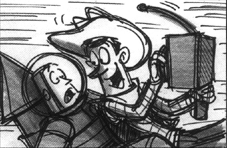 |
1 |
Storyboards Over 4,000 storyboard drawings are created as the blueprint for the action and dialog of a feature-length Pixar animated film. They are revised many times during the creative development process. |
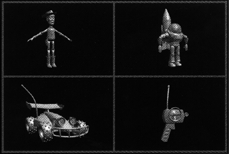 |
2 |
Modelling Pixar's proprietary animation software, Marionette, is used to create three-dimensional computer models of characters, props and sets. These computer models describe the shape of the object as well as the motion controls that the animators use to create movement and expressions. |
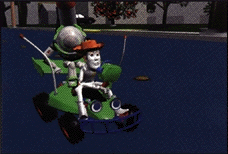 |
3 |
Animation Pixar's proprietary animation software allows Pixar's animators to choreograph the motion in each scene by defining key frames or poses. The computer then automatically creates the "in-between" frames, which the animator can adjust if necessary. Pixar's animators neither draw, nor paint the scenes, as is required in traditional animation. |
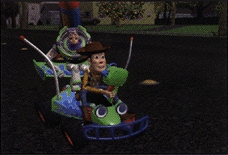 |
4 |
Shading Computer programs that describe surface characteristics, including textures, finishes and colors, are added to every object in the scene. These programs, called "shaders," can simulate a wide variety of appearances, including wood, metal, fabric, glass, hair and skin. |
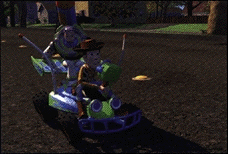 |
5 |
Lighting Using "digital lights," every scene is lit in much the same manner as stage lighting. Key, fill and bounce lights and room ambience are all defined and used to enhance the mood and emotion of each scene. |
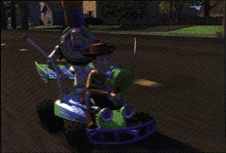 |
6 |
Rendering Pixar's RenderMan software "draws" the finished image by computing every pixel of the image from the model, animation, shading, and lighting information. Final rendered images use Pixar's patented motion blur, and each one can take from one to twenty hours of computation time to draw. Once rendered, final images are transferred to film, video or CD-ROM. |
PIXAR'S RENOWNED SHORTSAnimated entirely on computers, these miraculous shorts were the building blocks in the development of Pixar Animation Studios. The collection includes The Adventures of Andre and Wally B., Luxo Jr. (1986 Oscar nomination, Best Animated Short Film), Red's Dream, Tin Toy (1988 Academy Award-winner, Best Animated Film) and Knickknack.
 |
For The Birds (2000) For the Birds is a story about a flock of small birds perched on a telephone wire and a larger bird that tries to join them. The unwelcome bird upsets the flock, and they decide to get rid of him. For the Birds continues the Pixar tradition of creating short films that explore the creative and technical possibilities of animation. For the Birds is directed by Ralph Eggleston and produced by Karen Dufilho. John Lasseter is executive producer. |
PIXAR'S FOLLOWS THE ROAD TO GOLD
Article published by Videography
in August 2002.
When it comes to making full-length CGI features, Pixar Animation Studios wants to get one thing straight -- it's the story first, and the technology second -- that makes a great film. While movies like Toy Story and Monsters, Inc. were both huge box-office hits, the company stresses that although its use of high-end proprietary and off-the-shelf technology created some very unique characters and environments, it was always the stories that drove the projects. And, Pixar has the track record to prove it.
In 1995 Toy Story, its first full-length
computer-animated feature film with Walt Disney Pictures, was the highest-grossing
film, bringing in more than $192 million in domestic box office receipts
and $358 million worldwide, two Golden Globe Nominations, and several Academy
Award nominations including Best ScreenPlay Written Directly For The Screen.
Obviously a winning formula had been discovered, so the Pixar/Disney collaboration
continued. In 1998, A Bug's Life was
released and broke all previous U.S. Thanksgiving weekend box-office records.
The movie also became the highest grossing animated release of 1998, generating
more than $163 million in domestic box office sales and $362 million worldwide.
That same year, Pixar released an animated short film Geri's Game,
which marked new advances in the ability to animate skin and cloth (Pixar's
proprietary Marionette 3D animation system) and won the Academy Award for
Best Animated Short Film. In 1999, Pixar and Disney released Toy
Story 2, the first film in history to be entirely created, mastered,
and exhibited digitally, and the first animated sequel to gross more than
its original (earning more than $245 million in domestic box office receipts
and $485 million worldwide). By 2000, the picture received a Golden Globe
Award for Best Picture -- Musical or Comedy. In 2001, Monsters,
Inc. was released, breaking even more box-office records, reaching
the $100 million mark at the domestic box office in just nine days, faster
than any other animated film in history. The picture also became the second
highest grossing animated film of all-time (behind only Disney's The
Lion King).
In The Beginning
Feel free to take a minute here to catch your breath. Pixar's success grew rapidly from its beginnings as a spin-off group from Lucasfilm in 1986. Though the group was largely involved with experimental technology -- both hardware and software -- Pixar's tremendous success was by no means an accident. Right from the start, President and Co-founder Ed Catmull says the company had a plan. "When this group was first formed, there was John Lasseter, myself, and various other people which were all part of a core team that had already been in place and were working together for some years," he explains. "So, we thought the whole thing through. Our plan was to do shorts, then commercials, then a half-hour special on television, and then do a feature film. Our long-term goal was to do feature films. Even way back when, that's what we were after. We were going for the gold ring. But, at that time it wasn't economical and the tools weren't yet in place. In fact, the computer graphics community was pretty small. So, we started with a series of short films. Partly, it was to showcase the technology, but the bigger reason was to develop the technology further. By producing the shorts, we were forcing ourselves to expand our capabilities. We had to push hard on the tools." That year, Pixar's first animated short, Luxo Jr., made its world premiere at Siggraph. By 1987, the short received an Academy Award nomination for Best Animated Short Film. Pixar was well on its way.
The company moved according to plan. By 1989, it created its first commercial for Tropicana. "The reason for making commercials was two-fold," Catmull says. "One was that we couldn't afford to bring in more talent. The shorts just cost money, they don't actually make any money. So, by doing commercials, we were able to bring in some revenue and justify hiring some talent. Second, we wanted to subject ourselves to real production deadlines and pressures. It's one thing to do something for Siggraph one year, it's another to have to do something every ten weeks. We knew we needed to bring that kind of discipline in-house."
By 1995, and a slew of commercials later (even those won awards), the opportunity was presented for Pixar to become involved in making a feature film. Pixar received a phone call from Disney to do a feature. "At first I thought, 'that's not according to plan. We were supposed to do a half-hour special first,' " laughs Catmull. "So, we thought about it for one or two nano seconds and then said 'okay, we'll skip the TV part.'" And that's what became Toy Story.
"That was it, the life-time dream," recalls Catmull. "It isn't often you actually get to achieve a life-time dream. But Toy Story came out and we hit the goal. The issue then became, 'now what?' We were so focused on that goal that we hadn't thought about what came after that."
What came after that, in 1997, was an agreement with Disney to jointly produce five more features together.
Pete Docter, the supervising animator on Toy
Story and director of Monsters, Inc.
says "one of the reasons why I love working at Pixar is the company's emphasis
on story-telling and creating an emotional core to all the stories. I think
Toy
Story was such a success because we chose an idea that a lot of
us had as kids. A lot of people really believed their toys came to life
when they weren't looking -- or, at least, they secretly hoped they did.
And, I think the concept behind Monsters,
Inc. is very similar. We've all had ideas about monsters living
in the basement or under the bed that came out to scare us. So, we took
that idea that was very familiar to people and yet twisted it in a way
that people probably never thought of like monsters working at a factory
for instance."
Pushing The Technology Envelope
By that time, the company had already earned recognition from the computer and animation communities for its advancements in technology. Pixar had not only developed its Marionette 3D animation software, but it created CAPS (computer-assisted production system), RenderMan rendering software, and later for Monsters, Inc., Fizt, which stands for physics tool. This was developed mainly to create the hair and fur on the film's characters.
In addition to its proprietary software, Pixar uses Alias|Wavefront Maya, SGI workstations, Sun servers, and just about anything and everything that will help the creative team bring outrageous, colorful, and fantastic characters to life.
According to Docter, "Everybody's always scouting around to see what's out there. How do the tools work? What do we need? Do we need to develop our own software? From show to show, we'll change software platforms. I think Pixar is certainly a very innovative company in the computer graphics that we do. Everything we work on is very high-quality and we have some of the smartest people I know working here. What we decide to use really just depends on what works for us and what the needs of the show are. Everything is story driven. Not the other way around. We don't say, 'we have this cool fur technology, let's come up with a story that shows it off. When we started Monsters, Inc., I said I wanted fur for the characters. We didn't know how to do that, but we figured it out."
Doctor stresses, though, that "Having said all that, there have been other films that certainly have been very advanced-technologically -- but haven't done as well. I tend to think it's because of the lack of attention to the story and characters. That's the key. I think in Pixar's case, it's really the blend of the two. The story is most important, but we followed that up with really cool-looking graphics and techniques."
Catmull agrees. "Through all this development of technology, we never
forgot that this is not about the technology. This is about making movies
and telling stories. And, when the time actually comes for making the movie,
we let the stories drive the process. Something I was very proud of on
Toy
Story were the reviews. Almost every review had one, and only one
sentence saying this was the first computer graphics movie. The rest of
it was about the story that was being told. And, I remember thinking, 'We
did it.' Everybody here understands that. It's not a matter of technology
being more important than art or art being more important than technology,
it's that they are both in service of the story. After all, if you screw
up the story, none of this matters."
|
||||||||||||